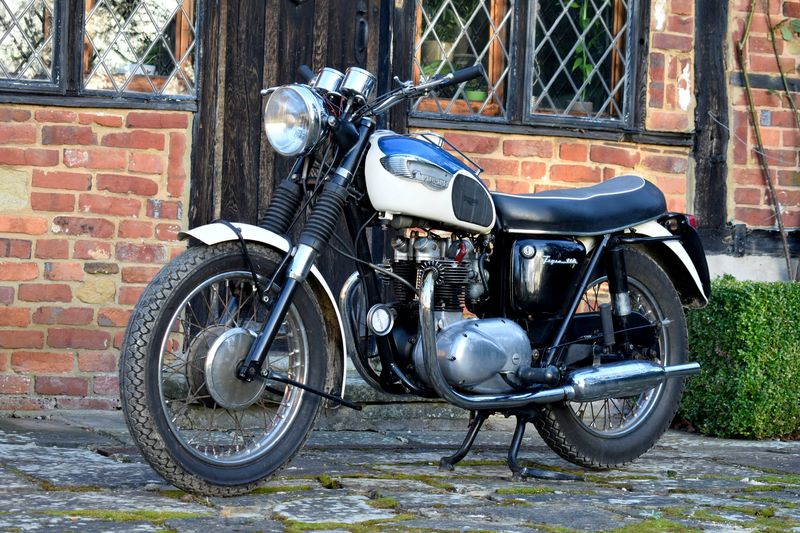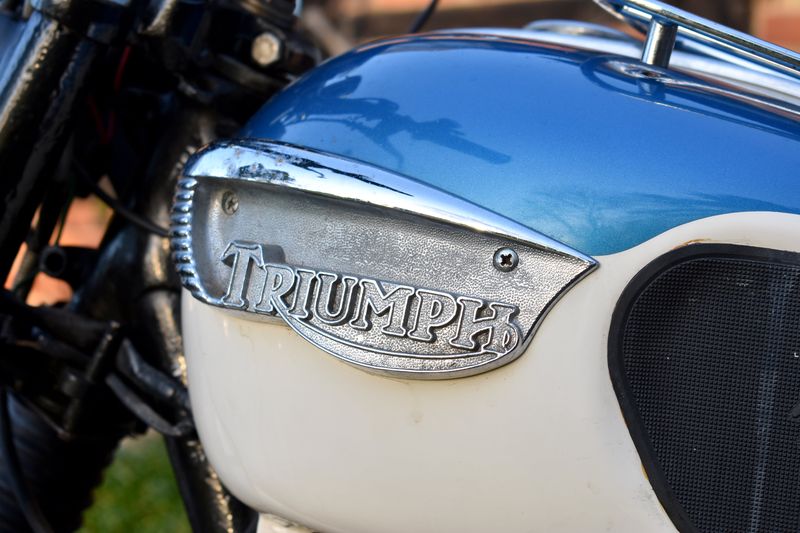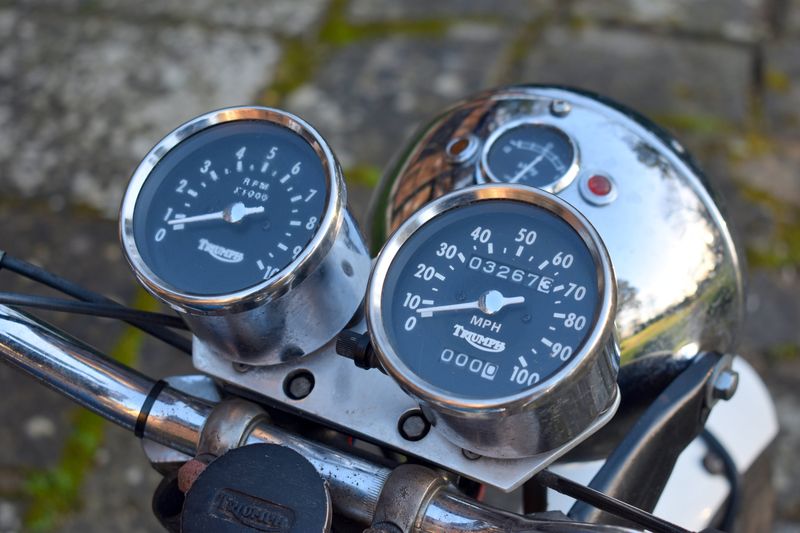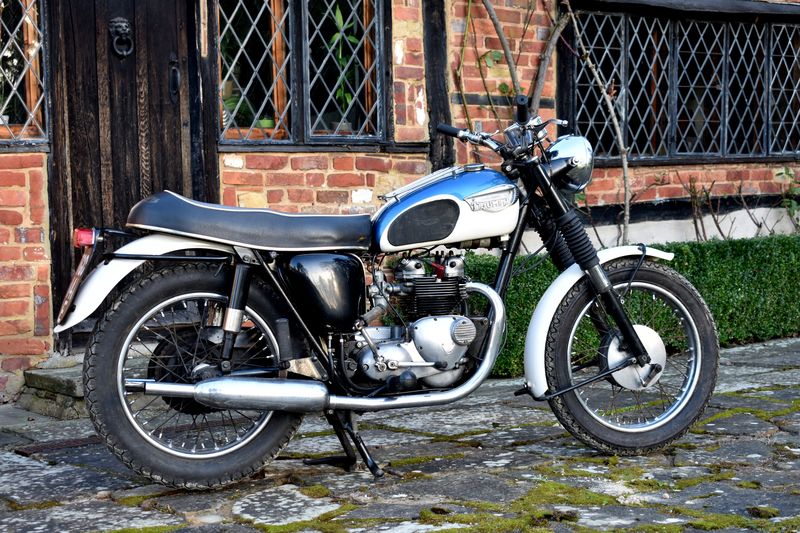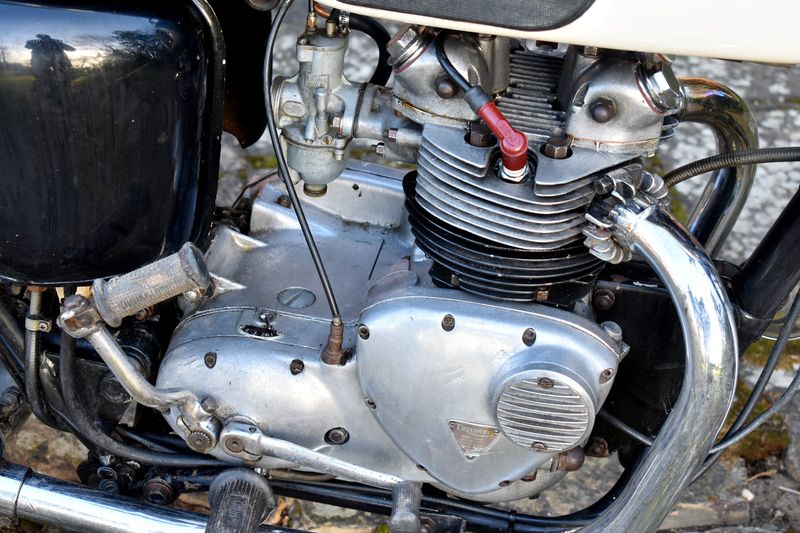Highlights
- Very low mileage
- Looks great and runs beautifully
- Offered for sale from one of the finest collections of classic British motorcycles
The Background
Like all the great Triumphs of the post-war years, the Tiger began life on the drawing board of Chief Designer Edward Turner. With the success of his 500cc Speed Twin proving the potential of Triumph’s new parallel twin engine, Turner set about developing it further and seeing that potential realised.
Turner had been appointed Chief Designer in 1936, and he worked quickly to make his new design a production reality. Improvements over the Speed Twin included one of the earliest uses of forged alloy pistons, with the cylinders held in place by eight studs as opposed to the Speed Twin’s six, plus a larger fuel tank and detachable silencers. The finished bike was ready for production in 1939 and christened the Tiger 100. Marketed at sporting motorcyclists, the 100 had real significance; it stood for 100 mph.
Of course, the war halted progress for a time, but afterwards it was developed further, gaining telescopic front forks and, from 1954, swing-arm rear suspension. Going into the ’50s, the Tiger was Triumph’s foremost sports offering and it built up a prolific competition record for itself as the decade wore on. As Triumph began the practice across its range of constructing its engines and gearboxes in one unit, the Tiger became a ‘unit’ bike from 1959.
The change to unit construction saw the Tiger significantly overhauled, first as the T100A and then as the T100S from 1962. Unusually for Triumphs of the time, the T100S did not début with the cumbersome ‘bathtub’ fairing, instead receiving the slimmed-down ‘bikini’ fairing, which was abandoned altogether in 1964. Other changes for the T100S included a free-standing chrome headlight instead of one housed in a nacelle and a slimmer front mudguard. All in all, it was much lighter than the T100A.
The T100S was popular and well-regarded in Britain and America. It achieved fame for Don Burnett’s victory at the 1962 Daytona 200 with a tuned T100S/R, the first time a Triumph had won at Daytona, but it also attracted infamy when Bob Dylan crashed his Tiger in 1966, leading him to withdraw from public life for eight years.
The History
In recent years, the Tiger has been in the possession of a longstanding motorcycle enthusiast and collector. Since its acquisition it has seen light use, and when not being ridden has occupied garage space alongside some of the finest names in British motorcycling from the 1920s to the present.
As a true enthusiast with the fullest appreciation of the motorcycles he owns, the owner enjoys riding all his machines. To that end, he does not keep them over-polished or trailer them around to shows, preferring instead to use them, with all that that entails. The vendor has taken sufficient care of his machines to ensure that they run like clockwork, start willingly and run smoothly and reliably. It is in that spirit that the Tiger has been maintained, and while it may not be concours, a better-running example will be hard to find.
The vendor retains an attachment to all his bikes, but the decision to start a new life in Sweden means the collection has to be sold.
The Paperwork
There is no paperwork accompanying the bike.
The Condition
The Triumph appears in lovely condition with just a light patina in places. We suspect that it has been the recipient of an older repaint or even full restoration, as the paint is generally in very good condition, although there are a few blemishes such as some chipping around the knee grips and the ‘Tiger 100’ badge on the toolbox.
Likewise, the seat looks to have been recovered in the past, although it has reached the point where, if you intended to use the bike for show purposes, you may wish to recover it again it does have several small splits in it, and the printed Triumph script on the rear is looking slightly faded.
The metal surfaces have all weathered a little bit, with a subtle patina spread across the wheels, headstock, exhaust pipe and the various chromed items. Whether you favour patina or not, what limited amount there is on the Tiger certainly does it no harm. After all, a bike should look like it gets used.
Generally, the bike is in very good cosmetic condition and is certainly highly presentable, albeit with room for cosmetic improvement in places if you so desired. A little bit of wear and tear makes it better suited to regular road use than something pristine, and we’d be quite happy to ride it just as it is.
The Mechanics
As with all the vendor’s bikes, the Tiger has been carefully maintained so that it runs very nicely and behaves well on the road. We have seen it run and are satisfied that all is in good order, although the vendor expressed a concern that it may be burning oil.
Since the bike does not have a current M.O.T., we are unable to make any guarantees as to its roadworthiness, but we cannot envisage it needing much, if anything, for it to sail straight through its next test.
The Appeal
Triumphs of the 1960s had style in spades. The flashy two-tone colour schemes, the relaxed riding position and a generous application of chrome combined to create something that was the height of coolness then and has only improved with age. Just put some shades on and find yourself a ’60s Triumph, and already you’re halfway to being Bob Dylan or Steve McQueen.
Conventional wisdom may say that the T120 Bonneville, as a development of the 650cc Tiger T110, is the one to go for on account of its supreme performance but, really, you’re unlikely to get the benefit of the extra performance when out on British roads, so is all the adulation and extra cost really justified? Perhaps not quite, considering just what a good bike the 500cc Tiger 100 is.
It may be a little slower, but it’s still a race-proven machine with plenty of get-up-and-go and all the good looks of its larger siblings. The Tiger 100 is a bike with a real sporting character you could use every day, and this is just the sort of example you’d want to use every day, being well-maintained but not too shiny.
Notice to bidders
It may be a little slower, but it’s still a race-proven machine with plenty of get-up-and-go and all the good looks of its larger siblings. The Tiger 100 is a bike with a real sporting character you could use every day, and this is just the sort of example you’d want to use every day, being well-maintained but not too shiny.
Notice to bidders
Although every care is taken to ensure this listing is as factual and transparent as possible, all details within the listing are subject to the information provided to us by the seller. Car & Classic does not take responsibility for any information missing from the listing. Please ensure you are satisfied with the vehicle description and all information provided before placing a bid.
As is normal for most auctions, this vehicle is sold as seen, and therefore the Sale of Goods Act 1979 does not apply. All bids are legally binding once placed. Any winning bidder who withdraws from a sale, is subject to our bidders fee charge. Please see our FAQs and T&C's for further information. Viewings of vehicles are encouraged, but entirely at the seller's discretion.

